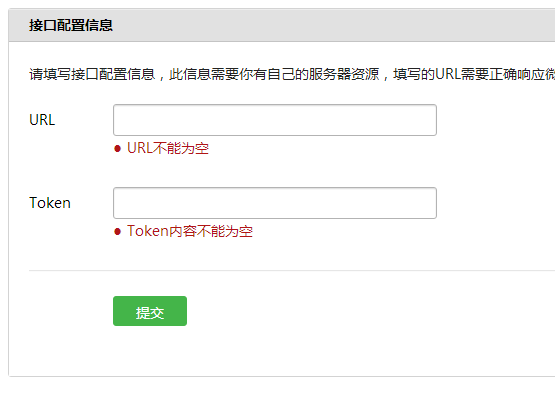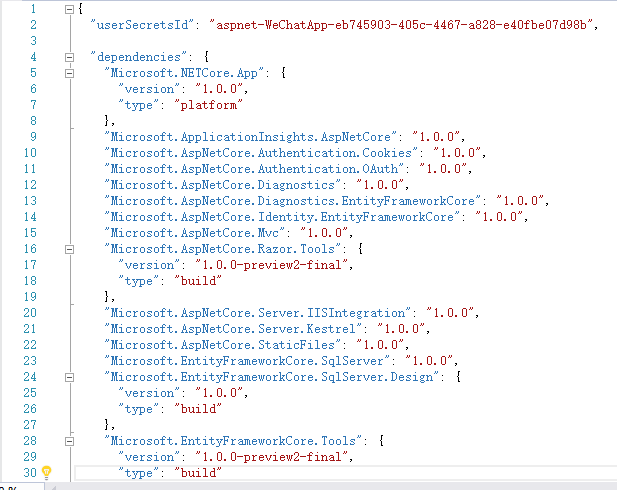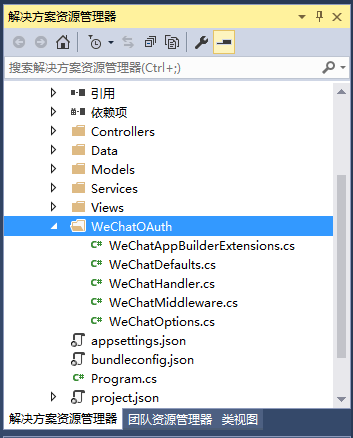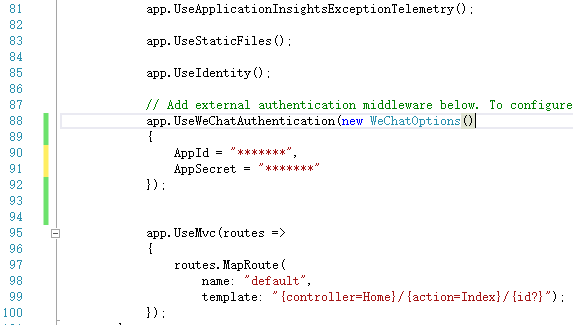工具:
Visual Studio 2015 update 3
Asp.Net Core 1.0
1 准备工作
申请微信公众平台接口测试帐号,申请网址:(http://mp.weixin.qq.com/debug/cgi-bin/sandbox?t=sandbox/login)。申请接口测试号无需公众帐号,可以直接体验和测试公众平台所有高级接口。
1.1 配置接口信息

1.2 修改网页授权信息

点击“修改”后在弹出页面填入你的网站域名:

2 新建网站项目
2.1 选择ASP.NET Core Web Application 模板

2.2 选择Web 应用程序,并更改身份验证为个人用户账户

3 集成微信登录功能
3.1添加引用
打开project.json文件,添加引用Microsoft.AspNetCore.Authentication.OAuth

3.2 添加代码文件
在项目中新建文件夹,命名为WeChatOAuth,并添加代码文件(本文最后附全部代码)。

3.3 注册微信登录中间件
打开Startup.cs文件,在Configure中添加代码:
app.UseWeChatAuthentication(new WeChatOptions()
{
AppId = "******",
AppSecret = "******"
});
注意该代码的插入位置必须在app.UseIdentity()下方。

4 代码

1 // Copyright (c) .NET Foundation. All rights reserved. 2 // Licensed under the Apache License, Version 2.0. See License.txt in the project root for license information. 3 4 using System; 5 using Microsoft.AspNetCore.Authentication.WeChat; 6 using Microsoft.Extensions.Options; 7 8 namespace Microsoft.AspNetCore.Builder 9 { 10 /// <summary> 11 /// Extension methods to add WeChat authentication capabilities to an HTTP application pipeline. 12 /// </summary> 13 public static class WeChatAppBuilderExtensions 14 { 15 /// <summary> 16 /// Adds the <see cref="WeChatMiddleware"/> middleware to the specified <see cref="IApplicationBuilder"/>, which enables WeChat authentication capabilities. 17 /// </summary> 18 /// <param name="app">The <see cref="IApplicationBuilder"/> to add the middleware to.</param> 19 /// <returns>A reference to this instance after the operation has completed.</returns> 20 public static IApplicationBuilder UseWeChatAuthentication(this IApplicationBuilder app) 21 { 22 if (app == null) 23 { 24 throw new ArgumentNullException(nameof(app)); 25 } 26 27 return app.UseMiddleware<WeChatMiddleware>(); 28 } 29 30 /// <summary> 31 /// Adds the <see cref="WeChatMiddleware"/> middleware to the specified <see cref="IApplicationBuilder"/>, which enables WeChat authentication capabilities. 32 /// </summary> 33 /// <param name="app">The <see cref="IApplicationBuilder"/> to add the middleware to.</param> 34 /// <param name="options">A <see cref="WeChatOptions"/> that specifies options for the middleware.</param> 35 /// <returns>A reference to this instance after the operation has completed.</returns> 36 public static IApplicationBuilder UseWeChatAuthentication(this IApplicationBuilder app, WeChatOptions options) 37 { 38 if (app == null) 39 { 40 throw new ArgumentNullException(nameof(app)); 41 } 42 if (options == null) 43 { 44 throw new ArgumentNullException(nameof(options)); 45 } 46 47 return app.UseMiddleware<WeChatMiddleware>(Options.Create(options)); 48 } 49 } 50 }

// Copyright (c) .NET Foundation. All rights reserved. // Licensed under the Apache License, Version 2.0. See License.txt in the project root for license information. namespace Microsoft.AspNetCore.Authentication.WeChat { public static class WeChatDefaults { public const string AuthenticationScheme = "WeChat"; public static readonly string AuthorizationEndpoint = "https://open.weixin.qq.com/connect/oauth2/authorize"; public static readonly string TokenEndpoint = "https://api.weixin.qq.com/sns/oauth2/access_token"; public static readonly string UserInformationEndpoint = "https://api.weixin.qq.com/sns/userinfo"; } }

// Copyright (c) .NET Foundation. All rights reserved. // Licensed under the Apache License, Version 2.0. See License.txt in the project root for license information. using Microsoft.AspNetCore.Authentication.OAuth; using Microsoft.AspNetCore.Builder; using Microsoft.AspNetCore.Http.Authentication; using Microsoft.AspNetCore.Http.Extensions; using Microsoft.Extensions.Primitives; using Newtonsoft.Json.Linq; using System; using System.Collections.Generic; using System.Net.Http; using System.Net.Http.Headers; using System.Security.Claims; using System.Text; using Microsoft.AspNetCore.Mvc; using System.Threading.Tasks; namespace Microsoft.AspNetCore.Authentication.WeChat { internal class WeChatHandler : OAuthHandler<WeChatOptions> { public WeChatHandler(HttpClient httpClient) : base(httpClient) { } protected override async Task<AuthenticateResult> HandleRemoteAuthenticateAsync() { AuthenticationProperties properties = null; var query = Request.Query; var error = query["error"]; if (!StringValues.IsNullOrEmpty(error)) { var failureMessage = new StringBuilder(); failureMessage.Append(error); var errorDescription = query["error_description"]; if (!StringValues.IsNullOrEmpty(errorDescription)) { failureMessage.Append(";Description=").Append(errorDescription); } var errorUri = query["error_uri"]; if (!StringValues.IsNullOrEmpty(errorUri)) { failureMessage.Append(";Uri=").Append(errorUri); } return AuthenticateResult.Fail(failureMessage.ToString()); } var code = query["code"]; var state = query["state"]; var oauthState = query["oauthstate"]; properties = Options.StateDataFormat.Unprotect(oauthState); if (state != Options.StateAddition || properties == null) { return AuthenticateResult.Fail("The oauth state was missing or invalid."); } // OAuth2 10.12 CSRF if (!ValidateCorrelationId(properties)) { return AuthenticateResult.Fail("Correlation failed."); } if (StringValues.IsNullOrEmpty(code)) { return AuthenticateResult.Fail("Code was not found."); } //获取tokens var tokens = await ExchangeCodeAsync(code, BuildRedirectUri(Options.CallbackPath)); var identity = new ClaimsIdentity(Options.ClaimsIssuer); AuthenticationTicket ticket = null; if (Options.WeChatScope == Options.InfoScope) { //获取用户信息 ticket = await CreateTicketAsync(identity, properties, tokens); } else { //不获取信息,只使用openid identity.AddClaim(new Claim(ClaimTypes.NameIdentifier, tokens.TokenType, ClaimValueTypes.String, Options.ClaimsIssuer)); ticket = new AuthenticationTicket(new ClaimsPrincipal(identity), properties, Options.AuthenticationScheme); } if (ticket != null) { return AuthenticateResult.Success(ticket); } else { return AuthenticateResult.Fail("Failed to retrieve user information from remote server."); } } /// <summary> /// OAuth第一步,获取code /// </summary> /// <param name="properties"></param> /// <param name="redirectUri"></param> /// <returns></returns> protected override string BuildChallengeUrl(AuthenticationProperties properties, string redirectUri) { //加密OAuth状态 var oauthstate = Options.StateDataFormat.Protect(properties); // redirectUri = $"{redirectUri}?{nameof(oauthstate)}={oauthstate}"; var queryBuilder = new QueryBuilder() { { "appid", Options.ClientId }, { "redirect_uri", redirectUri }, { "response_type", "code" }, { "scope", Options.WeChatScope }, { "state", Options.StateAddition }, }; return Options.AuthorizationEndpoint + queryBuilder.ToString(); } /// <summary> /// OAuth第二步,获取token /// </summary> /// <param name="code"></param> /// <param name="redirectUri"></param> /// <returns></returns> protected override async Task<OAuthTokenResponse> ExchangeCodeAsync(string code, string redirectUri) { var tokenRequestParameters = new Dictionary<string, string>() { { "appid", Options.ClientId }, { "secret", Options.ClientSecret }, { "code", code }, { "grant_type", "authorization_code" }, }; var requestContent = new FormUrlEncodedContent(tokenRequestParameters); var requestMessage = new HttpRequestMessage(HttpMethod.Post, Options.TokenEndpoint); requestMessage.Headers.Accept.Add(new MediaTypeWithQualityHeaderValue("application/json")); requestMessage.Content = requestContent; var response = await Backchannel.SendAsync(requestMessage, Context.RequestAborted); if (response.IsSuccessStatusCode) { var payload = JObject.Parse(await response.Content.ReadAsStringAsync()); string ErrCode = payload.Value<string>("errcode"); string ErrMsg = payload.Value<string>("errmsg"); if (!string.IsNullOrEmpty(ErrCode) | !string.IsNullOrEmpty(ErrMsg)) { return OAuthTokenResponse.Failed(new Exception($"ErrCode:{ErrCode},ErrMsg:{ErrMsg}")); } var tokens = OAuthTokenResponse.Success(payload); //借用TokenType属性保存openid tokens.TokenType = payload.Value<string>("openid"); return tokens; } else { var error = "OAuth token endpoint failure"; return OAuthTokenResponse.Failed(new Exception(error)); } } /// <summary> /// OAuth第四步,获取用户信息 /// </summary> /// <param name="identity"></param> /// <param name="properties"></param> /// <param name="tokens"></param> /// <returns></returns> protected override async Task<AuthenticationTicket> CreateTicketAsync(ClaimsIdentity identity, AuthenticationProperties properties, OAuthTokenResponse tokens) { var queryBuilder = new QueryBuilder() { { "access_token", tokens.AccessToken }, { "openid", tokens.TokenType },//在第二步中,openid被存入TokenType属性 { "lang", "zh_CN" } }; var infoRequest = Options.UserInformationEndpoint + queryBuilder.ToString(); var response = await Backchannel.GetAsync(infoRequest, Context.RequestAborted); if (!response.IsSuccessStatusCode) { throw new HttpRequestException($"Failed to retrieve WeChat user information ({response.StatusCode}) Please check if the authentication information is correct and the corresponding WeChat Graph API is enabled."); } var user = JObject.Parse(await response.Content.ReadAsStringAsync()); var ticket = new AuthenticationTicket(new ClaimsPrincipal(identity), properties, Options.AuthenticationScheme); var context = new OAuthCreatingTicketContext(ticket, Context, Options, Backchannel, tokens, user); var identifier = user.Value<string>("openid"); if (!string.IsNullOrEmpty(identifier)) { identity.AddClaim(new Claim(ClaimTypes.NameIdentifier, identifier, ClaimValueTypes.String, Options.ClaimsIssuer)); } var nickname = user.Value<string>("nickname"); if (!string.IsNullOrEmpty(nickname)) { identity.AddClaim(new Claim(ClaimTypes.Name, nickname, ClaimValueTypes.String, Options.ClaimsIssuer)); } var sex = user.Value<string>("sex"); if (!string.IsNullOrEmpty(sex)) { identity.AddClaim(new Claim("urn:WeChat:sex", sex, ClaimValueTypes.String, Options.ClaimsIssuer)); } var country = user.Value<string>("country"); if (!string.IsNullOrEmpty(country)) { identity.AddClaim(new Claim(ClaimTypes.Country, country, ClaimValueTypes.String, Options.ClaimsIssuer)); } var province = user.Value<string>("province"); if (!string.IsNullOrEmpty(province)) { identity.AddClaim(new Claim(ClaimTypes.StateOrProvince, province, ClaimValueTypes.String, Options.ClaimsIssuer)); } var city = user.Value<string>("city"); if (!string.IsNullOrEmpty(city)) { identity.AddClaim(new Claim("urn:WeChat:city", city, ClaimValueTypes.String, Options.ClaimsIssuer)); } var headimgurl = user.Value<string>("headimgurl"); if (!string.IsNullOrEmpty(headimgurl)) { identity.AddClaim(new Claim("urn:WeChat:headimgurl", headimgurl, ClaimValueTypes.String, Options.ClaimsIssuer)); } var unionid = user.Value<string>("unionid"); if (!string.IsNullOrEmpty(unionid)) { identity.AddClaim(new Claim("urn:WeChat:unionid", unionid, ClaimValueTypes.String, Options.ClaimsIssuer)); } await Options.Events.CreatingTicket(context); return context.Ticket; } } }

// Copyright (c) .NET Foundation. All rights reserved. // Licensed under the Apache License, Version 2.0. See License.txt in the project root for license information. using System; using System.Globalization; using System.Text.Encodings.Web; using Microsoft.AspNetCore.Authentication.OAuth; using Microsoft.AspNetCore.Builder; using Microsoft.AspNetCore.DataProtection; using Microsoft.AspNetCore.Http; using Microsoft.Extensions.Logging; using Microsoft.Extensions.Options; namespace Microsoft.AspNetCore.Authentication.WeChat { /// <summary> /// An ASP.NET Core middleware for authenticating users using WeChat. /// </summary> public class WeChatMiddleware : OAuthMiddleware<WeChatOptions> { /// <summary> /// Initializes a new <see cref="WeChatMiddleware"/>. /// </summary> /// <param name="next">The next middleware in the HTTP pipeline to invoke.</param> /// <param name="dataProtectionProvider"></param> /// <param name="loggerFactory"></param> /// <param name="encoder"></param> /// <param name="sharedOptions"></param> /// <param name="options">Configuration options for the middleware.</param> public WeChatMiddleware( RequestDelegate next, IDataProtectionProvider dataProtectionProvider, ILoggerFactory loggerFactory, UrlEncoder encoder, IOptions<SharedAuthenticationOptions> sharedOptions, IOptions<WeChatOptions> options) : base(next, dataProtectionProvider, loggerFactory, encoder, sharedOptions, options) { if (next == null) { throw new ArgumentNullException(nameof(next)); } if (dataProtectionProvider == null) { throw new ArgumentNullException(nameof(dataProtectionProvider)); } if (loggerFactory == null) { throw new ArgumentNullException(nameof(loggerFactory)); } if (encoder == null) { throw new ArgumentNullException(nameof(encoder)); } if (sharedOptions == null) { throw new ArgumentNullException(nameof(sharedOptions)); } if (options == null) { throw new ArgumentNullException(nameof(options)); } if (string.IsNullOrEmpty(Options.AppId)) { throw new ArgumentException(string.Format(CultureInfo.CurrentCulture, nameof(Options.AppId))); } if (string.IsNullOrEmpty(Options.AppSecret)) { throw new ArgumentException(string.Format(CultureInfo.CurrentCulture, nameof(Options.AppSecret))); } } /// <summary> /// Provides the <see cref="AuthenticationHandler{T}"/> object for processing authentication-related requests. /// </summary> /// <returns>An <see cref="AuthenticationHandler{T}"/> configured with the <see cref="WeChatOptions"/> supplied to the constructor.</returns> protected override AuthenticationHandler<WeChatOptions> CreateHandler() { return new WeChatHandler(Backchannel); } } }

// Copyright (c) .NET Foundation. All rights reserved. // Licensed under the Apache License, Version 2.0. See License.txt in the project root for license information. using System.Collections.Generic; using Microsoft.AspNetCore.Authentication.WeChat; using Microsoft.AspNetCore.Http; using Microsoft.AspNetCore.Identity; namespace Microsoft.AspNetCore.Builder { /// <summary> /// Configuration options for <see cref="WeChatMiddleware"/>. /// </summary> public class WeChatOptions : OAuthOptions { /// <summary> /// Initializes a new <see cref="WeChatOptions"/>. /// </summary> public WeChatOptions() { AuthenticationScheme = WeChatDefaults.AuthenticationScheme; DisplayName = AuthenticationScheme; CallbackPath = new PathString("/signin-wechat"); StateAddition = "#wechat_redirect"; AuthorizationEndpoint = WeChatDefaults.AuthorizationEndpoint; TokenEndpoint = WeChatDefaults.TokenEndpoint; UserInformationEndpoint = WeChatDefaults.UserInformationEndpoint; //SaveTokens = true; //BaseScope (不弹出授权页面,直接跳转,只能获取用户openid), //InfoScope (弹出授权页面,可通过openid拿到昵称、性别、所在地。并且,即使在未关注的情况下,只要用户授权,也能获取其信息) WeChatScope = InfoScope; } // WeChat uses a non-standard term for this field. /// <summary> /// Gets or sets the WeChat-assigned appId. /// </summary> public string AppId { get { return ClientId; } set { ClientId = value; } } // WeChat uses a non-standard term for this field. /// <summary> /// Gets or sets the WeChat-assigned app secret. /// </summary> public string AppSecret { get { return ClientSecret; } set { ClientSecret = value; } } public string StateAddition { get; set; } public string WeChatScope { get; set; } public string BaseScope = "snsapi_base"; public string InfoScope = "snsapi_userinfo"; } }
